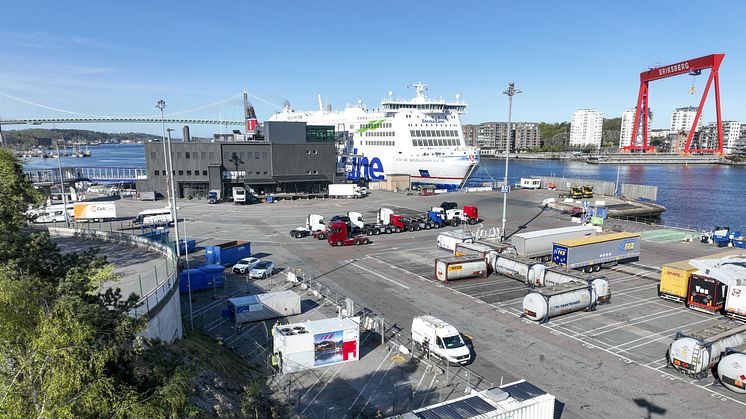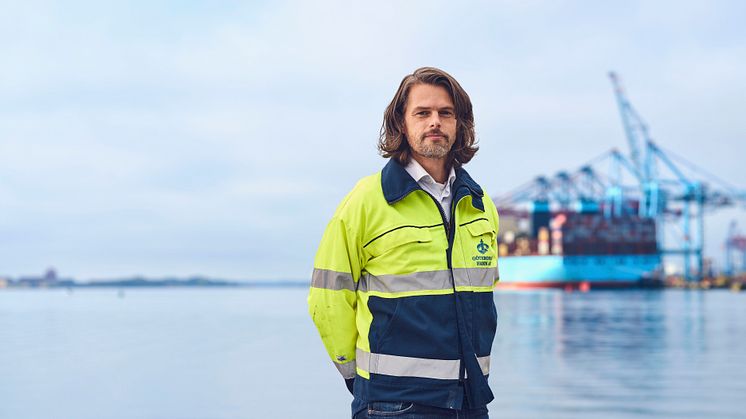
Press release -
Hydrogen powers ships with electricity in pilot test at the Port of Gothenburg
A pilot project using a hydrogen generator to supply electricity to ships docked at the Port of Gothenburg is now in its final phase. The method may pave the way for reduced emissions in other ports where conventional shore power connections are not feasible.
Powering ships with electricity instead of using their conventional engines while docked can save large amounts of carbon dioxide emissions*. The first facilities for connecting ships to shore-side electricity—known as On-shore Power Supply (OPS)—were installed at the Port of Gothenburg in the early 2000s. At that time, the OPS-facilities at Stena Line’s terminals for Germany and Denmark traffic were among the first of their kind in the world.
However, many other ports in the EU and across the globe have not come as far and often lack necessary prerequisites. OPS systems require significant investment as well as a robust underlying electrical infrastructure in the ports.
In such ports, alternative solutions are needed. Mobile hydrogen generators, like the one currently being tested at Stena Line’s Germany terminal, may offer a promising way forward.
As part of a two-week pilot project, a hydrogen-powered generator has been connected to Stena Line’s existing shore power facility at the Port of Gothenburg. Using green hydrogen as fuel, the generator has supplied electricity to the vessel Stena Germanica and Stena Scandinavica while docked.
"At Stena Line, we are eager to collaborate to test new technologies aimed at reducing emissions from our industry. This project shows that there are alternative solutions for ports that lack the infrastructure for shore power," says Anders Peterson, Group Head of Port Development & Engineering at Stena Line.
A Potential Way to Meet Stricter Regulations
In 2030, a new EU regulation will come into effect requiring container and passenger vessels to use OPS while at berth. According to a study by ICCT, this is expected to reduce emissions by just over one million tonnes of carbon dioxide per year. According to Viktor Allgurén, Head of Innovation at the Port of Gothenburg, hydrogen could help ports meet these requirements:
"Since the climate is a shared concern for us all, it is also in everyone’s interest that as many ports as possible around us succeed in meeting these demands. With our extensive experience in OPS, we are pleased to partner with Stena Line to serve as a testbed for this new technology, which may very well prove to be a viable solution for many ports," says Viktor Allgurén.
The hydrogen generator being tested at the Port of Gothenburg was developed by Hitachi Energy, whose technology partner PowerCell Group supplies the generator’s power modules and expertise in fuel cell integration. During the test, the generator used 100% green hydrogen supplied by gas producer Linde Gas.
"We are very pleased with the results of the latest collaboration with Stena Line, PowerCell Group, Linde Gas, and the Port of Gothenburg. We value working with these industry players to continue exploring new application areas for HyFlex and to demonstrate its broad potential—from construction sites to port terminals—to accelerate the energy transition," says Tobias Hansson, Managing Director of Hitachi Energy in Sweden.
Hydrogen as a fuel has a range of potential applications in a port context. Today, the Port of Gothenburg has a hydrogen refueling station for trucks, hydrogen-powered work vehicles are currently being tested, and the technology used in the current OPS trial has also recently been used in the port by Skanska to power heavy machinery in a major terminal expansion project.
* According to a report from the European Parliamentary Research Service (EPRS), between 6 and 7% of carbon dioxide emissions from the shipping sector are generated while ships are docked at ports within the European Economic Area (EEA).
Topics
Fact file: Port of Gothenburg
The Port of Gothenburg is the largest port in Scandinavia. Around 20% of Swedish foreign trade and over 50% of all container traffic is handled in the Port of Gothenburg . The port is a full-service port, and offers industry guaranteed, climate-smart access to the whole world. Direct services to key markets ensure highly efficient, sustainable, and reliable transport 24 hours a day, 365 days a year. The focus is firmly on sustainability, innovation, and digitalisation in a concerted effort to maintain the ongoing development of climate-efficient freight transport and calls by vessels. With over 30 rail shuttles offering daily departures, companies throughout Sweden and Norway have a direct, climate-neutral service to the Port of Gothenburg. The port handles energy products, vehicles, ro-ro units, containers and passengers.
Follow us on:
Facebook
Instagram
LinkedIn
Twitter
www.portofgothenburg.com



